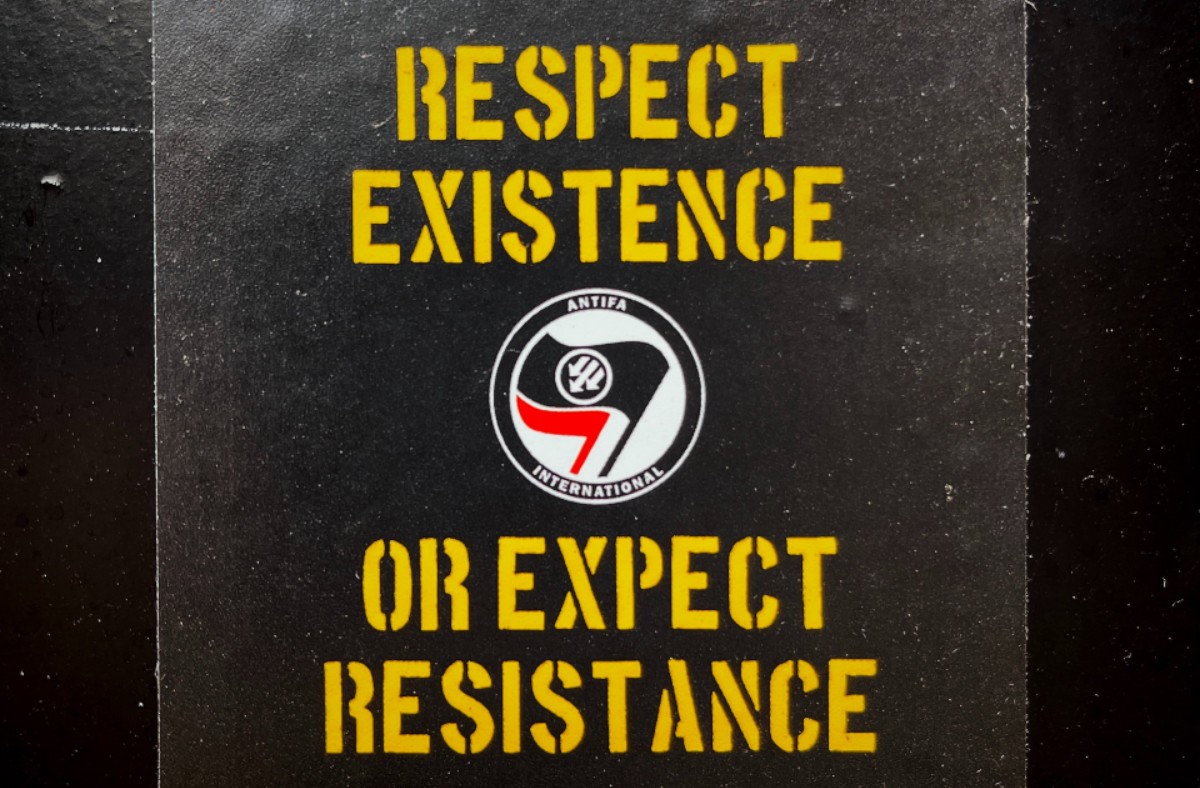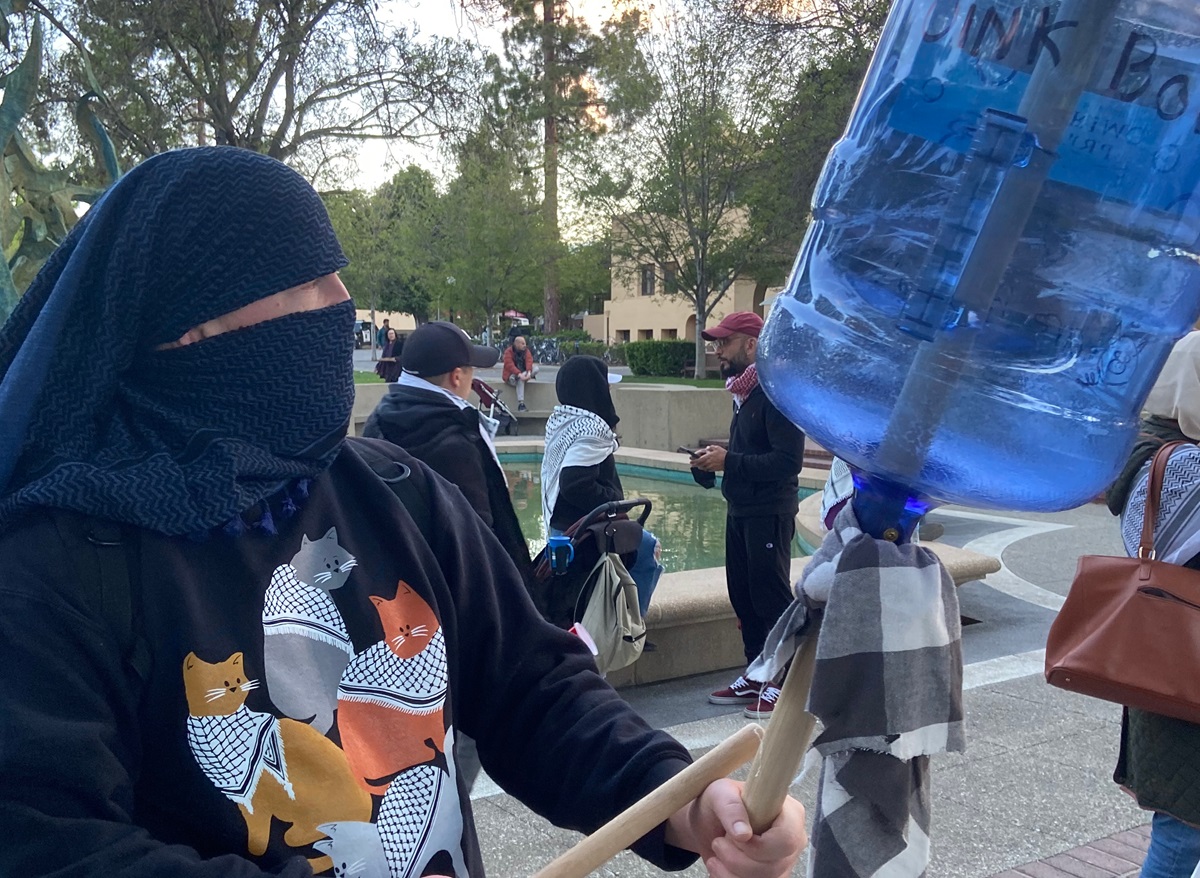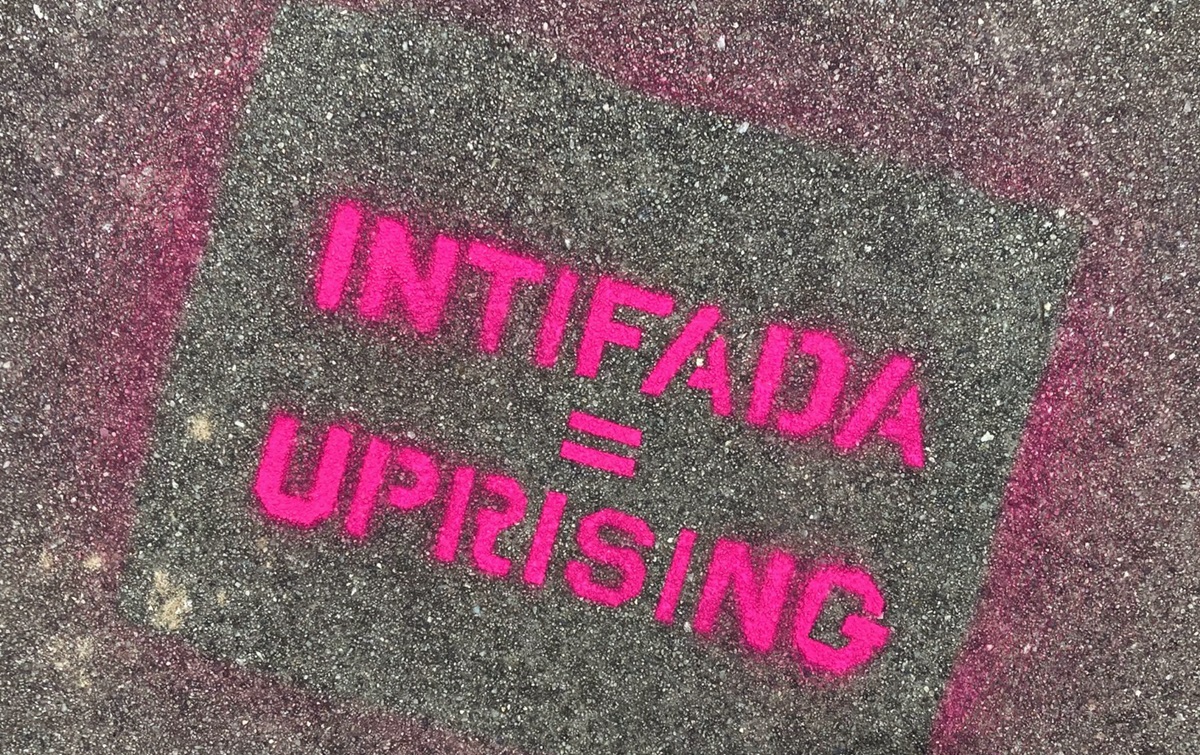Filed under: Anarchist Movement, Anti-fascist, Critique, US

Another critical look at the changing terrain of antifascist struggle. Originally posted to Three Way Fight.
by Iain W
I stood in a crowd of white men, blending in seamlessly. I was just another white man. The moment of hostility came when I failed to recite the Pledge of Allegiance, failed to take off my hat, and didn’t put my hand over my heart. I hadn’t chosen to out myself, it’s just that it never occurred to be to participate in that particular performance. It was April 15, 2009, and I was checking out a Tea Party Rally in Downtown Portland.
Past the dwindling Nazi Bonehead sets, this city was leftist property. So, it was mostly a curiosity to see so many Republicans in one place.
There were several features that haunt me from that day. There were more Carhartts then khakis in the crowd, and younger people included, some wearing the Guy Fawkes mask, a sure sign of political incoherence. From the stage the speakers had no real problem calling for armed revolt and bloodletting, watering the tree of liberty and such. The GOP had no problem with the rhetoric, signing up voters for the next midterms: the GOP has always been a good deal more radical then the Democrats. The Koch brothers produced signs they carried had the slogan “runaway taxes + huge government = SLAVERY.” The “slavery” was in bold type, and from a distance all you saw was a bunch of white men carrying a sign that said “slavery.” Obama as The Joker would come along a bit later.
I recall thinking, not at that time, but in the year or so that followed, that no one seemed to be confronting the Tea Party, with its barely coded white supremacy and expression of an actual mass participatory base. It felt like a void, waiting to be filled, but the push-back never materialized. It was a missed opportunity. That same yawning chasm would open up just a few years later with Trump, but the void would be filled with the far-Left, most specifically by existing anarchist and communist cadre/affinity groups, to become known broadly as “antifa” in the press. In some ways, antifa is a trap, a narrowing of the scope of concern or proactive solutions for hundreds of millions of people wallowing in the wreckage of late capitalism. Antifascism requires fascism for meaning, and cannot help but sweep such limitations into its scope.
But back in 2009, most of us saw only the theoretical possibility of the Tea Party slipping its libertarian corporate masters, and asserting itself as a nominally autonomous social force. We, my political collectivity included, were mostly still fighting the last war, against the remnants of the Nazi bonehead crews.
The shadow war that took place in the decades before the current era was mostly one over counter-cultural social spaces, and territory within urban centers. This is where most the ARA tactics that got folded into ‘antifa,’ the “we go where they go” and “no platforming” developed. In those times, most of the work was physical confrontation and street level violence, undermining of Nazi and white supremacist public events and organizing, and doxing before doxing was called doxing.
What this was, was political repression — of course. We actively repressed our enemies. And the constituency for the war against the far-Right was the counter-cultural punk scene. In a few places, because of good work, thoughtful organizing, and decent politics, that broke past the punk scene, and incorporated broader social layers into the fight against the fascists. But by and large, aside from salacious TV shows, that war was off the national radar. Nazis and conscious white supremacists were just as marginalized as the far-Left confronting them. Official society didn’t have much use for either of us, contrary to our shared assumptions about each other.
When Donald Trump came along, he lit the fuse to the powder keg that the elites had been packing since the 2008 capitalist collapse. And things started moving, well, rather quickly. A toxic brew of the far-Right started bubbling away: 3%ers, Patriot Prayer, the Proud Boys, Spencer’s Nazi’s, and a grab bag of other forces contended for Trump’s coattails. By and large, the Nazis and overt white nationalists lost this struggle, both within the rightist coalition, and through persecution, from the state and from the Left. But the remainder is perhaps more dangerous, and a graver threat to the Left and marginalized groups, not so much for its overt virulence, but its reach and potential popular grassroots support.
In typical liberal fashion, the progressive establishment had no answer for the rise of a far-Right as an actual movement organizing in the streets. But the far-Left stepped into that role, and suddenly became a social force with recognition on a national, if not international level. This was, and continues to be, a fundamental transformation of the political conversation in society, and a profound opportunity. To a large degree, I think we have squandered it, and are being out-maneuvered by reactionary forces.
I think most of our shortcomings lie in our fidelity to the frameworks that got built over the last several decades in confronting the far-right, and how they fail to scale up to today’s moment. There seems to be little conversation about the implications of the new terrain we occupy, just attempts to reapply inherited tactics built in a different era.
Our first shaky foundation is “no platforming,” the notion that some perspectives are simply too abhorrent to allow public space, and must be repressed. It relies ultimately on a social sanction from the wider community; it demands that a side be taken, and precludes any debate of ideas. What this requires is that social intuitions, the music clubs, the media outlets, the universities, and people in control of physical spaces and infrastructure agree to where this line is. If they fail to pick our side, they have to pay a public price, and maybe some insurance deductibles as well.
When “we go where they go” got coined, there were not several quality digital cameras on most commercial buildings. Most people did not have a video camera in their pocket. The media was composed of professionals working for slow-footed corporate newsrooms, and did not cover the beat down of a few peckerwoods at the local bar. It was a strategy of relentless pressure on the social spaces Nazis tried to cultivate and infiltrate. We do not live in that world today. When we went where they went, chances were it would not end up in court.
When we think about the community we had been accountable to, it was us, the far-Left, mostly a counter-cultural nexus composed of a few hundred to a few thousand people in most urban centers across the country. We had a rather high degree of shared values, on paper at any rate. Even here, disagreements are sharp, and propel us towards unending schism while we cancel each other — sometimes for heinous behavior, sometimes over petty sectarian beefs, often for a refusal to extend any good faith or mutual humility towards each other. But through most of it we all could get on board together for smashing Nazis.
Today, many of the dynamics that constructed the tactics we follow are gone. Surveillance is everywhere. The media system has been shattered into thousands of little shards. The internet makes new ways to communicate and share information, and algorithms sit above it all, gathering information for whoever can afford to buy it. The social forces operating today on all sides have exploded past the rather narrow parameters we operated in for the last several decades. The entire world has shifted under us, and we have played a role in it. But our categories and understandings that inform our tactics are pretty stubborn things, and we should ask if we cling to them to explain the world to ourselves, or just to explain ourselves to each other.
It feels like we are attempting to shove the new world back into the old one. Black Bloc attacks the media, even small-time stringers who may be sympathetic. It attacks passers-by that may have the gall to film a few hundred people blocked up in the middle of a downtown core, in the middle of the day. The bloc demands no one record or film them, when every person has a video camera in their pocket, and a platform to share content with millions of people around the world almost instantly. Does one imagine this is a winning, or even a feasible strategy? And what is the outcome of such approaches?
We should be clear: this is repression of the press, and even of the general public. It’s not a flattering feature, and it’s more than a PR problem. It’s a question of how power operates, and what we do with ours. There may be a rational kernel behind it, but it opens up another set of questions, and has implications for the sort of confidences we might prefer people have in us. If we subordinate other people’s freedoms for our security, there’s little chance to win society over to a liberatory project through our pathways. More than likely, people will find the public repressive display alienating and repulsive. The marginal security that is gained from attacking the press and the public costs incalculable credibility with society.
As to the second cornerstone of antifa, “We Go Where They Go” has increasingly become its opposite. We don’t “go where they go,” because we have no organized presence in the places they go, and no plan or capacity to build that. Right now the Proud Boys have no end of social space to occupy in the exurbs. Nor is it very likely that the owners of the bars would give two shits about an attempt at cancellation. They would use it as a marketing strategy, emboldening and empowering reaction. So, we are left with fights in the urban cores that we are used to defending, and “going where they go” is really them coming to where we are. On August 22nd this was clear as could be, when a small group of people perhaps too literally applied the slogan.
When we look at no platforming, it is often the act of no platforming that constructs the very platform reactionaries stand on. This is what the current debate about cancel culture is, and I believe the right is winning there. Jordan Peterson is a great example. He would still be an obscure professor in Canada, teaching esoteric Jungian garbage to a handful of zoned out Canadians had he not seen the opportunity to build a brand on the “illiberal” left. His ideas have strength mostly because we won’t be bothered to push them over, as doing so would only legitimize him, so the thinking goes. But here we miss the point.
It’s not always clear where one puts the marker down for a refusal to debate ideas we find abhorrent. When fascism is clear cut, it’s easy to repress it. But what about ideas that tens or even hundreds of millions of people hold as “common sense”? Do we imagine that we will repress those millions of people into accepting our notions of how the world is organized? Because if you don’t work to confront reactionary ideas that have been broadly perpetrated as common sense through argument and discussion, what’s our other option, besides, you know, defeat?
Our notions of the social base of fascists often fails to recognize the disparate and contradictory elements within the broader milieu of far-Right organizing, at times pushing forces together we should be looking to tear apart. We point at a truck carrying a black man, a pacific islander, and a woman shooting paintballs at leftists and call them white supremacists. Fascism is a dynamic force that we try to fit into static categories at our peril. They are making a play to cohere a new broad base, while we narrow ours to “people we can trust.” Any study of revolution will show a dizzying array of mind-bending coalitions and temporary alliances so deep with contradictions and betrayals that any solid ground we find ourselves on should be foremost taken as illusion.
Such observations must be made with humility, but I have little doubt that we are moving into even sharper times, where millions and millions of people will be drawn into a struggle to survive. We should not be deterministic about where people will jump based on our own categories, be they gendered, racial or class-informed. These are abstractions developed in a certain time, and must constantly be reassessed through acute awareness and curiosity, not simply replicated through confirmation bias. Our goal must be to build structures that can encompass the desires and dreams of hundreds of millions of people, to split the mass base away from systems of hierarchy towards egalitarian liberty and human solidarity.
We will need to be more thoughtful towards showing people a world we want to build, a more open hand than closed fist. This is not an argument against political repression, or for pacifism. There should be no doubt violence and political repression will be elements to what’s ahead. Fascists should be smashed, but it does not always need to be a public spectacle, and may be more effective, and safer when it’s not. Such a context does require narrow participation, high levels of security, but it bumps less up against the perhaps greater need for mass participatory activity — not only against fascism, but for a different world. It requires less collateral repression of media actors and the general public. And when it is the repression of fascists is a public spectacle, the concern should be in decisive victories that enjoy popular support.
Iain W is a part-time leftist who lives in Portland, OR and occasionally tries to be useful.
photo: Jon Tyson via Unsplash





